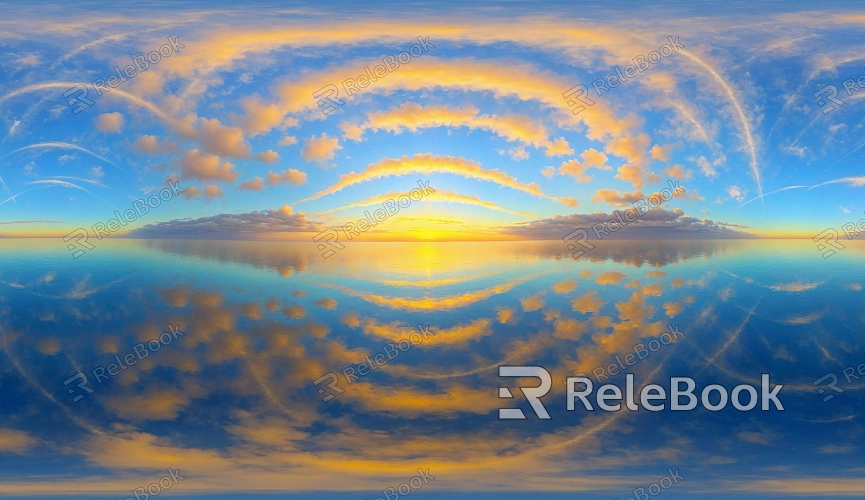What is the Difference Between HDR and Regular Skybox Textures
Skyboxes are widely used to simulate environments in 3D scenes, whether for architectural visualization, game design, or movie special effects. They provide realistic background atmospheres for virtual environments. However, when using skyboxes, designers often face a common dilemma: Should they choose HDR textures or regular skybox textures? This question frequently arises in software like Blender, 3ds Max, and Cinema 4D. In this article, we will explore the key differences between HDR and regular skybox textures, helping you understand how to make the right choice based on your project needs.

1. Lighting Detail and Dynamic Range
The most significant difference between HDR and regular skybox textures lies in the level of detail and dynamic range in lighting.
HDR Texture's Handling of Brightness and Darkness: HDR textures capture a high dynamic range of lighting variations in a scene, allowing them to process more light information, especially in very bright or dark areas. This makes HDR textures ideal for delivering natural and realistic lighting effects, particularly in complex scenes with subtle light transitions.
Limitations of Regular Skyboxes: In contrast, regular skybox textures (LDR, low dynamic range) contain limited lighting information. This means they cannot accurately display details in overly bright or dark areas, which may result in flatter or distorted lighting effects in your scene.
2. Differences in Visual Realism
One of the critical factors in choosing skyboxes is visual quality, and HDR textures generally outperform in this area.
Realistic Reflections in HDR Textures: An HDR skybox not only provides realistic lighting but also influences how objects in the scene reflect light. Surfaces within the scene can reflect and refract light more precisely based on the lighting information embedded in HDR textures, significantly enhancing the overall realism.
Reflection Limitations in Regular Textures: Regular skybox textures cannot deliver the same quality of reflection, especially when rendering materials with metallic or glossy surfaces. As a result, reflections in scenes using regular textures often appear less accurate or natural.
3. File Size and Performance Impact
File size and performance are practical considerations when choosing between these two texture types.
Larger File Sizes with HDR: HDR textures store much more lighting data, which results in significantly larger file sizes compared to regular textures. In large-scale scenes or projects that require frequent texture loading, HDR textures may consume more storage and computing resources.
Lighter Regular Skyboxes: Regular textures, due to their smaller amount of lighting data, have more compact file sizes and perform better in terms of resource efficiency, making them particularly useful for projects with tight rendering speed requirements.
4. Rendering Requirements and Hardware Support
The rendering needs and hardware capabilities of a project can also influence which type of texture is more suitable.
Higher Hardware Requirements for HDR: Rendering HDR textures demands more from your hardware, requiring the system to support high dynamic range processing. Without this support, the final render quality may be compromised. High-end graphics cards and more powerful CPUs are often needed to handle HDR textures effectively.
Lower Requirements for Regular Skyboxes: On the other hand, regular textures place fewer demands on hardware, making them a better fit for environments with limited resources, such as mobile devices or older hardware.

5. Suitability for Different Scene Purposes
The specific purpose of your scene also plays a role in deciding whether to use HDR or regular skybox textures.
HDR for Realistic Lighting Simulations: For projects like architectural visualization, movie effects, or high-end gaming environments that require natural lighting and environmental reflections, HDR textures are the top choice due to their superior quality.
Regular Textures for Quick Prototyping: If your project has lower lighting and detail demands or is intended for rapid prototyping, regular skyboxes can help you achieve your goal quickly while also reducing the hardware load.
6. Flexibility in Post-Processing
Post-production needs are another factor that designers must consider when selecting textures.
HDR Offers More Post-Processing Options: Because HDR textures capture a wider range of lighting data, they allow for more flexibility in post-processing. Designers can make fine-tuned adjustments to exposure, contrast, and other parameters after rendering to optimize the final image.
Post-Processing Limitations of Regular Textures: Regular skyboxes, with their limited dynamic range, offer less room for post-production adjustments. As a result, they are more prone to overexposure or loss of detail in both bright and dark areas.
7. Software Support
Different 3D design software programs vary in their support for HDR and regular skybox textures.
Mainstream Software Supports HDR: Today, most leading 3D design software, including Blender, 3ds Max, and Cinema 4D, support HDR textures, allowing designers to fully utilize the advantages of HDR for rendering purposes.
Regular Texture Compatibility: While regular textures are also compatible with these programs, their performance in areas such as lighting and reflection may be limited, especially in scenes that demand complex light and shadow dynamics.
8. Cost and Resource Considerations
Finally, budget and project resources are important factors in choosing between HDR and regular textures.
Higher Costs with HDR Textures: Creating or purchasing high-quality HDR textures often involves higher costs, which can be a significant consideration for independent designers or small teams working with limited budgets.
More Affordable Regular Skyboxes: Regular textures, by comparison, are generally more accessible and affordable, making them a viable alternative when working within resource constraints.
By understanding the differences between HDR and regular skybox textures, you can make better decisions on how to apply them in different scenarios. Whether you're aiming for high-quality lighting effects or working on quick scene development with limited resources, knowing these distinctions will help you choose the right option for your project.
If you're looking for high-quality HDR images, 3D textures, or models for software like SketchUp or 3ds Max to create your virtual environments, Relebook offers a wide selection to help you achieve outstanding visual results in your projects.

